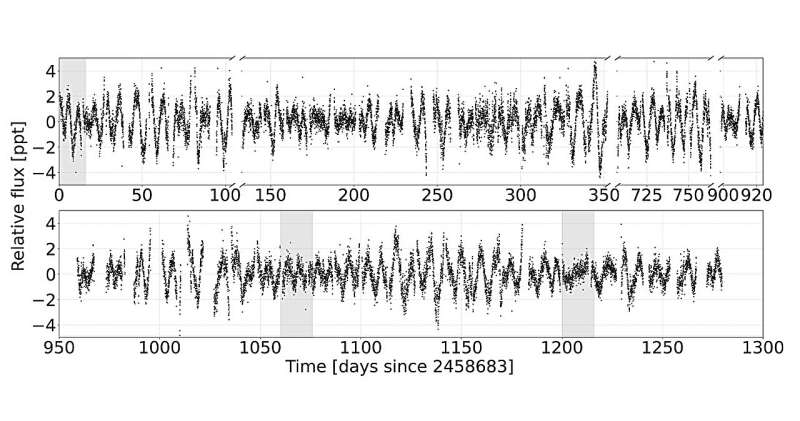February 20, 2024 report
This article has been reviewed according to Science X's editorial process and policies. Editors have highlighted the following attributes while ensuring the content's credibility:
fact-checked
preprint
trusted source
proofread
New ultra-short-period exoplanet discovered

Using NASA's Transiting Exoplanet Survey Satellite (TESS), astronomers have detected a new ultra-short-period exoplanet. The newly found alien world is nearly two times larger than the Earth and orbits its host star in less than one day. The finding was reported in a paper published February 12 on the preprint server arXiv.
To date, TESS has identified more than 7,000 candidate exoplanets (TESS Objects of Interest, or TOI), of which 417 have been confirmed so far. Since its launch in April 2018, the satellite has been conducting a survey of about 200,000 of the brightest stars near the sun with the aim of searching for transiting exoplanets—ranging from small, rocky worlds to gaseous giants.
Now, a group of astronomers led by Ryan A. Rubenzahl of the California Institute of Technology (Caltech) has confirmed another TOI monitored by TESS. Rubenzahl's team reports that the transit signal identified in the light curve of a star known as TOI-1347 is of planetary nature.
"We present the confirmation and characterization of the USP [ultra-short-period] TOI-1347 b, a 1.8 ± 0.1 Earth radii planet on a 0.85-day orbit that was detected with photometry from the TESS mission," the researchers wrote in the paper.
As noted in the study, TOI-1437 b has a radius of about 1.8 Earth radii and is some 11.1 times more massive than our planet, which yields a bulk density at a level of 9.9 g/cm3. It takes the planet approximately 20 hours and 20 minutes to orbit the parent star. The astronomers estimate that TOI-1437 b has an equilibrium temperature of around 1,400 K as it orbits its host at a distance of some 4.43 solar radii from it.
The researchers noted that TOI-1437 b has most likely an Earth-like composition and is so far the most massive USP among the ones with radii smaller than 2.0 Earth radii. The results also suggest that the planet has a high-mean-molecular-weight atmosphere. However, this needs to be further confirmed, using, for instance, the James Webb Space Telescope (JWST).
When it comes to the host star TOI-1437 (also known as TIC 229747848), it is a late G-type star showcasing strong variability. It has a radius of about 0.83 solar radii, while its mass was measured to be 0.91 solar masses. The star is estimated to be about 1.4 billion years old and its effective temperature is 5,464 K.
Besides the confirmation of TOI-1437 b as an exoplanet, Rubenzahl's team also reports the detection of another, smaller planet in the system. The extrasolar world, which received designation TOI-1437 c, is slightly smaller than TOI-1437 b as it has a radius of approximately 1.6 Earth radii. Given that the authors of the paper were unable to identify this planet with radial velocity measurements, they placed an upper limit for its mass—at 6.4 Earth masses.
More information: Ryan A. Rubenzahl et al, The TESS-Keck Survey. XII. A Dense 1.8 R⊕ Ultra-Short-Period Planet Possibly Clinging to a High-Mean-Molecular-Weight Atmosphere After the First Gyr, arXiv (2024). DOI: 10.48550/arxiv.2402.07451
Journal information: arXiv
© 2024 Science X Network



















